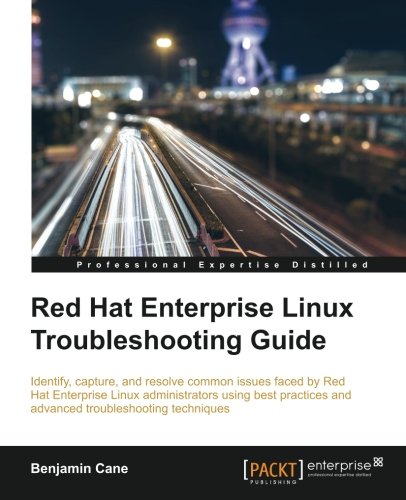
Red Hat Enterprise Linux Troubleshooting Guide
- Length: 458 pages
- Edition: 1
- Language: English
- Publisher: Packt Publishing
- Publication Date: 2015-11-02
- ISBN-10: 1785283553
- ISBN-13: 9781785283550
- Sales Rank: #735086 (See Top 100 Books)
Identify, capture and resolve common issues faced by Red Hat Enterprise Linux administrators using best practices and advanced troubleshooting techniques
About This Book
- Develop a strong understanding of the base tools available within Red Hat Enterprise Linux (RHEL) and how to utilize these tools to troubleshoot and resolve real-world issues
- Gain hidden tips and techniques to help you quickly detect the reason for poor network/storage performance
- Troubleshoot your RHEL to isolate problems using this example-oriented guide full of real-world solutions
Who This Book Is For
If you have a basic knowledge of Linux from administration or consultant experience and wish to add to your Red Hat Enterprise Linux troubleshooting skills, then this book is ideal for you. The ability to navigate and use basic Linux commands is expected.
What You Will Learn
- Identify issues that need rapid resolution against long term root cause analysis
- Discover commands for testing network connectivity such as telnet, netstat, ping, ip and curl
- Spot performance issues with commands such as top, ps, free, iostat, and vmstat
- Use tcpdump for traffic analysis
- Repair a degraded file system and rebuild a software raid
- Identify and troubleshoot hardware issues using dmesg
- Troubleshoot custom applications with strace and knowledge of Linux resource limitations
In Detail
Red Hat Enterprise Linux is an operating system that allows you to modernize your infrastructure, boost efficiency through virtualization, and finally prepare your data center for an open, hybrid cloud IT architecture. It provides the stability to take on today’s challenges and the flexibility to adapt to tomorrow’s demands.
In this book, you begin with simple troubleshooting best practices and get an overview of the Linux commands used for troubleshooting. The book will cover the troubleshooting methods for web applications and services such as Apache and MySQL. Then, you will learn to identify system performance bottlenecks and troubleshoot network issues; all while learning about vital troubleshooting steps such as understanding the problem statement, establishing a hypothesis, and understanding trial, error, and documentation. Next, the book will show you how to capture and analyze network traffic, use advanced system troubleshooting tools such as strace, tcpdump & dmesg, and discover common issues with system defaults.
Finally, the book will take you through a detailed root cause analysis of an unexpected reboot where you will learn to recover a downed system.
Style and approach
This is an easy-to-follow guide packed with examples of real-world core Linux concepts. All the topics are presented in detail while you’re performing the actual troubleshooting steps.
Table of Contents
Chapter 1. Troubleshooting Best Practices
Chapter 2. Troubleshooting Commands and Sources of Useful Information
Chapter 3. Troubleshooting a Web Application
Chapter 4. Troubleshooting Performance Issues
Chapter 5. Network Troubleshooting
Chapter 6. Diagnosing and Correcting Firewall Issues
Chapter 7. Filesystem Errors and Recovery
Chapter 8. Hardware Troubleshooting
Chapter 9. Using System Tools to Troubleshoot Applications
Chapter 10. Understanding Linux User and Kernel Limits
Chapter 11. Recovering from Common Failures
Chapter 12. Root Cause Analysis of an Unexpected Reboot







